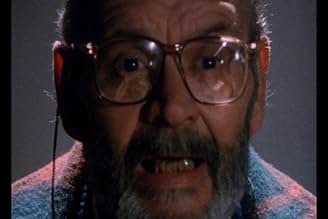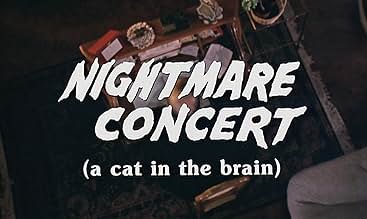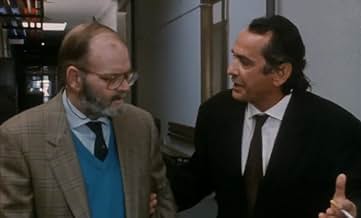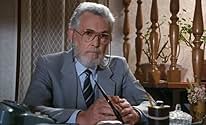NOTE IMDb
5,5/10
4,1 k
MA NOTE
Ajouter une intrigue dans votre langueA horror film director is stalked by a mad psychiatrist/serial killer bent on killing people to model the killings after the director's gory death scenes from his movies.A horror film director is stalked by a mad psychiatrist/serial killer bent on killing people to model the killings after the director's gory death scenes from his movies.A horror film director is stalked by a mad psychiatrist/serial killer bent on killing people to model the killings after the director's gory death scenes from his movies.
- Réalisation
- Scénario
- Casting principal
Brett Halsey
- The Monster
- (images d'archives)
Ria De Simone
- The Soprano
- (images d'archives)
- (as Ria Desimon)
Sacha Darwin
- Woman in Oven
- (images d'archives)
Robert Egon
- Second Monster
- (images d'archives)
- …
Malisa Longo
- Katya Schwarz
- (as Melissa Lang)
Paola Cozzo
- Nurse Lilly
- (as Judy Morrow)
Adriana Russo
- Nightmare Victim
- (images d'archives)
- (as Layla Frank)
Luciana Ottaviani
- Nightmare Victim
- (images d'archives)
- (as Georgia Moore)
Paul Muller
- Nightmare Victim
- (images d'archives)
Marco Di Stefano
- Nightmare Victim
- (images d'archives)
Maurice Poli
- Nightmare Victim
- (images d'archives)
Lubka Lenzi
- Nightmare Victim
- (images d'archives)
Claudio Aliotti
- Nightmare Victim
- (images d'archives)
- (non crédité)
Annie Belle
- Nightmare Victim
- (images d'archives)
- (non crédité)
Avis à la une
Contrary to some of the more credulous comments posted here, no way is Cat in the Brain "the goriest film ever made". Even mainstream movies such as Romero's Zombies and Day of the Dead are much gorier, as is Fulci's own Zombie Flesh Eaters. (If you want serious gore, check out Peter Jackson's marvellous Brain Dead, aka Dead Alive, the Flymo massacre at the climax of which is probably the single goriest scene ever committed to celluloid.) There are numerous gory moments, sure, but most of the time the SFX are really shoddy and unconvincing; many - most? - of the murderous vignettes are lifted from Fulci's Italian TV movies, and boy, does it show.
The movie itself is very cheap and unbelievably inept. One gets the impression Fulci cobbled it together in about half an hour. The narrative is hopelessly disjointed, and the acting would disgrace a school play. There's also a nasty vein of misogyny running through it: nearly all the murder victims are women, often nude or semi-nude, and their deaths are dwelt on lovingly and at length. This is a lamentable trend in modern horror movies, and Fulci, bless his little cotton socks, has consistently shown himself to be one of the worst offenders. The guy clearly got off on showing women being tortured and killed - New York Ripper, anybody? - and by watching his films, we the audience are participating, albeit vicariously, in the vile behaviour depicted. Where does that leave us, I wonder? (Incidentally, Brian De Palma's thriller Body Double offers an interesting commentary about this uneasy relationship between actress, director and audience in a "stalk and slash" movie.)
Nevertheless, this is an interesting film, if only for the ironic self-reflection in which Fulci indulges. Okay, so it's not a totally original conceit, but the notion of a horror film director feeling constrained by audience expectation such that he can no longer make movies in any other genre is one worth exploring. (Compare the career of Alfred Hitchcock, who complained that if he made a version of Mary Poppins, the audience would be asking "where's the body?") Also, Fulci does appear to be saying that he himself is sickened by the atrocities he depicts, to the extent that they're sending him loopy. Whether or not Fulci really felt the way his character - a film director by the name of, you've guessed it, Lucio Fulci - feels is debatable; after all, horror made him famous, and, presumably, rich. And coming from the director of New York Ripper, any protest he might be making does seem rather disingenuous.
I also like the notion of a film within a film within a film; playing around with the audience's viewpoint, and emphasising the voyeuristic nature of the whole filmmaking process.
Whatever else, Cat in the Brain is worth seeing just for the scene in which Fulci molests a woman during one of his funny turns. When he apologises later, the woman gushes "Ooh, Mr. Fulci, that's the biggest thrill I've ever had in my life!" (or words to that effect). Fulci's reaction? Well, you'll have to see it for yourself, but it had me in stitches.
The movie itself is very cheap and unbelievably inept. One gets the impression Fulci cobbled it together in about half an hour. The narrative is hopelessly disjointed, and the acting would disgrace a school play. There's also a nasty vein of misogyny running through it: nearly all the murder victims are women, often nude or semi-nude, and their deaths are dwelt on lovingly and at length. This is a lamentable trend in modern horror movies, and Fulci, bless his little cotton socks, has consistently shown himself to be one of the worst offenders. The guy clearly got off on showing women being tortured and killed - New York Ripper, anybody? - and by watching his films, we the audience are participating, albeit vicariously, in the vile behaviour depicted. Where does that leave us, I wonder? (Incidentally, Brian De Palma's thriller Body Double offers an interesting commentary about this uneasy relationship between actress, director and audience in a "stalk and slash" movie.)
Nevertheless, this is an interesting film, if only for the ironic self-reflection in which Fulci indulges. Okay, so it's not a totally original conceit, but the notion of a horror film director feeling constrained by audience expectation such that he can no longer make movies in any other genre is one worth exploring. (Compare the career of Alfred Hitchcock, who complained that if he made a version of Mary Poppins, the audience would be asking "where's the body?") Also, Fulci does appear to be saying that he himself is sickened by the atrocities he depicts, to the extent that they're sending him loopy. Whether or not Fulci really felt the way his character - a film director by the name of, you've guessed it, Lucio Fulci - feels is debatable; after all, horror made him famous, and, presumably, rich. And coming from the director of New York Ripper, any protest he might be making does seem rather disingenuous.
I also like the notion of a film within a film within a film; playing around with the audience's viewpoint, and emphasising the voyeuristic nature of the whole filmmaking process.
Whatever else, Cat in the Brain is worth seeing just for the scene in which Fulci molests a woman during one of his funny turns. When he apologises later, the woman gushes "Ooh, Mr. Fulci, that's the biggest thrill I've ever had in my life!" (or words to that effect). Fulci's reaction? Well, you'll have to see it for yourself, but it had me in stitches.
As one who often paid good coin to see Fulci movies during their brief theatrical runs, I can appreciate the guilty pleasure of kicking back to hoot at badly-dubbed sadism and cheesy gore. But I draw the line at clods who insist that Lucio Fulci was some kind of tortured, misunderstood artist. Better you should write theses on the mise-en-scene of AIRPORT 1975, or maybe the underlying theme of ROLLER BOOGIE. There's no doubt Fulci was intending to shock his audience with mean-spirited viciousness; however, his ham-handed obviousness and ineptitude are what make his films "classics". I haven't seen BEATRICE CENCI or that DUCKLING one, so maybe there was some real talent there once. But from ZOMBIE onward, Fulci delivered more unintentional comedy than on-purpose terror. CAT IN THE BRAIN is probably his worst ever, a hopeless porridge of old gore-fx footage spliced into new scenes in an excruciating attempt at a psychological thriller. A horror-film director slowly losing his ability to distinguish reality from fantasy IS a scenario ripe with possibilities: wait till you see how badly this simple-yet-solid premise is botched. Or better yet, take my word for it and pass altogether. I hold no personal animus against the late Fulci, but it irritates me no end that this guy is slowly gaining a reputation as some kind of great Italian moviemaker - mostly from lazy gorehounds who can't be bothered to check out De Sica, Rossellini, Visconti or legit horror masters like Bava and Freda. Maybe CAT IN THE BRAIN isn't representative of Fulci's best -he was in failing health at the time- but I've seen his other "triumphs" and his only genius was in aiming low - and missing.
"Cat In The Brain" is a series of extremely violent sequences knitted together by a plot that feels more like an overview, describing director Lucio Fulci's most notorious years of film-making. The movie could also be seen as a dark comedy of sorts, effectively spoofing the various claims that violent cinema causes violence in real life. Fulci goes further than that, he casts himself as the star, the central figure of the film thus showing the audience who is the man behind all the cinematic gore. "Cat in The Brain" is not about presenting a clear story and following it. Instead it pokes fun at some of the clichés that have been surrounding the horror genre for years.
Lucio Fulci plays himself as a horror director struggling to keep his humanity intact. Years of violent film making have finally began to reach him. It starts slowly, steaks and meat in general begin to disgust him, his colleagues assure Fulci that all he needs is some rest. But that doesn't help and soon the grotesque ideas for his movies begin to overwhelm his daily thoughts. In an attempt to find a cure for his dangerously maddening mental state Lucio starts going to the local psychiatrist. Unfortunately that does more wrong than good and Fulci is thrown into an even bigger mess, as the psychiatrist turns out to be a psychopath, who mimics the murders from Fulci's films in real life.
The film retains all the trademarks of Italian splatter cinema, good or bad they are all here. So any comments about the acting or the technical aspects and budget constrains are quite irrelevant as to the quality of the film. It is a visual experience, no doubts about it. Fulci throws in an incredible amount of violence easily surpassing pretty much everything he's made. Amputated by chainsaw limbs, cannibalism, child murder, decapitation, these are just some of the many grotesque acts witnessed in "Cat In The Brain". Some of them are obviously recycled from a few the director's less profile movies but they don't stand out of the context, and actually feel quite at home here. As I noted before the movie exists much better as a satire of the genre rather than a serious piece. The way some of the violence is presented does help establish that idea. Such sequences shortly after climax are rejected by the reality in the film, as they are revealed to be actually scenes inside a movie that Fulci's character is directing. This sort of "film in film" presentation lessens somewhat the impact of the gore. But in no way does it make it an easy to watch film. Oh no this is far beyond and above the levels of gore found in mainstream horror, and gorehounds will in no doubt be satisfied with that fact.
Lucio Fulci was a very polarized figure. People either hate his work or love it. "Cat in the Brain" won't convince any of Fulci's detractors in the opposite but it is nevertheless an interesting part of his filmography. One that fans should really check out.
Lucio Fulci plays himself as a horror director struggling to keep his humanity intact. Years of violent film making have finally began to reach him. It starts slowly, steaks and meat in general begin to disgust him, his colleagues assure Fulci that all he needs is some rest. But that doesn't help and soon the grotesque ideas for his movies begin to overwhelm his daily thoughts. In an attempt to find a cure for his dangerously maddening mental state Lucio starts going to the local psychiatrist. Unfortunately that does more wrong than good and Fulci is thrown into an even bigger mess, as the psychiatrist turns out to be a psychopath, who mimics the murders from Fulci's films in real life.
The film retains all the trademarks of Italian splatter cinema, good or bad they are all here. So any comments about the acting or the technical aspects and budget constrains are quite irrelevant as to the quality of the film. It is a visual experience, no doubts about it. Fulci throws in an incredible amount of violence easily surpassing pretty much everything he's made. Amputated by chainsaw limbs, cannibalism, child murder, decapitation, these are just some of the many grotesque acts witnessed in "Cat In The Brain". Some of them are obviously recycled from a few the director's less profile movies but they don't stand out of the context, and actually feel quite at home here. As I noted before the movie exists much better as a satire of the genre rather than a serious piece. The way some of the violence is presented does help establish that idea. Such sequences shortly after climax are rejected by the reality in the film, as they are revealed to be actually scenes inside a movie that Fulci's character is directing. This sort of "film in film" presentation lessens somewhat the impact of the gore. But in no way does it make it an easy to watch film. Oh no this is far beyond and above the levels of gore found in mainstream horror, and gorehounds will in no doubt be satisfied with that fact.
Lucio Fulci was a very polarized figure. People either hate his work or love it. "Cat in the Brain" won't convince any of Fulci's detractors in the opposite but it is nevertheless an interesting part of his filmography. One that fans should really check out.
Forget THE BEYOND--CAT IN THE BRAIN is Lucio Fulci's masterpiece. If Dario Argento is the John Ford of Italian splatter cinema, the lyric poet and publicly acknowledged grand-master, then Fulci was surely its Howard Hawks--the caretaker and solid storyteller who knew how to sink a hole in one with the easiest flick of the wrist. Splatter-geeks somehow seem to have dismissed this picture with a contemptuous shrug--maybe it's too highbrow and "conceptual" for their red-meat tastes. In a stroke of daring even Fellini and Michael Powell never tried in their self-reflexive classics, Fulci plays himself--or rather, a particularly tormented and increasingly unhinged version of himself, driven mad by the combination of guilt and bloodlust triggered by making hyperviolent horror movies. "Fulci" wonders whether he is responsible for a string of gruesome murders breaking out around him...and the movie's combination of a fiendish, id-driven love of cinema, and a shuddering revulsion at its consequences, makes this for me the most painful and personal of all movies about moviemaking. The author's conflicting emotions are played out as nakedly as in VERTIGO or BLOW OUT--only this movie has the illicit fun of its grindhouse origins. Horror afficianados may have given this picture the high hat, but I know it has at least one fan...Jean-Luc Godard.
Its bittersweet to see Lucio Fulci slumming in a film that is mostly cheap, unoriginal gore effects and dull filler footage, but Fulci bares more of his persona and sincerity to this film than his much better films. Playing himself in a ludicrous giallo plot, Fulci plays a "Greatest Hits" of his parlor tricks and cheapest techniques. This is even cheaper than his later work so there's nothing inventive or sophisticated in his camera-work or cinematography I'm afraid. But Lucio plays with his own identity and genre trappings. He returns to his roots in slapstick comedy and straightforward giallo and merges it with his metaphysical horror and psychotic splatter. It doesn't hang together as a good movie, but an interesting experiment and fun experience for fans who love him. Its a love letter to fans from a dying artist. He didn't get the chance to make great works too often, but he always had the vision and energy and even something this bizarre and unsuccessful is evidence of some kind of genius Fulci had. This is a fitting reflection of him and his imperfect but audacious career and soul.
Le saviez-vous
- AnecdotesThe original script was 49 pages long and contained no dialogue. It consisted of descriptions of bodily mutilations/imagery and sound effects that would compliment them on screen.
- GaffesWhen one of the victims gets her throat slit with a piano wire, we see blood running from her mouth and onto her chin - however between shots, we don't see the woman spitting up the blood.
- Versions alternativesGerman video version was cut down to 67 minutes but still got a "Not under 18" rating.
- ConnexionsEdited from Il fantasma di Sodoma (1988)
Meilleurs choix
Connectez-vous pour évaluer et suivre la liste de favoris afin de recevoir des recommandations personnalisées
- How long is A Cat in the Brain?Alimenté par Alexa
Détails
Box-office
- Budget
- 100 000 $US (estimé)
- Durée1 heure 33 minutes
- Rapport de forme
- 1.66 : 1
Contribuer à cette page
Suggérer une modification ou ajouter du contenu manquant

Lacune principale
By what name was Nightmare concert (1990) officially released in India in English?
Répondre































